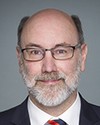Thank you, Madam Chair.
My thanks to the witnesses for joining us.
Madam Chair, before I ask questions, I would like to make a comment for your consideration.
In his opening remarks, the witness referred to four documents he had submitted. However, I have learned that those documents are currently being translated. Because of their volume, they are not available in French.
When we plan our list of witnesses, we should ensure that witnesses only appear once the documents are distributed to everyone in both languages. If I had had all the documents in French, my preparation and my questions would have been significantly different. I probably would have found the answers to my questions in the documents and could have probed further. However, that's impossible.
Could we ensure that we receive the documents in both official languages before hearing the witnesses in committee? It would be much appreciated. I leave that for your consideration, Madam Chair.
I will now turn to you, Mr. Boud. You have already answered one of my questions in your opening remarks. You said that it seemed difficult to apply the conclusions of Helios' report for Toronto Pearson International Airport to each of the airports. There must still be some features that apply to all the airports you have studied.
Would it be fair to say that there can be two types of recommendations: recommendations for all the airports that are experiencing the same problem related to the surrounding communities and recommendations specific to each of the airports?




